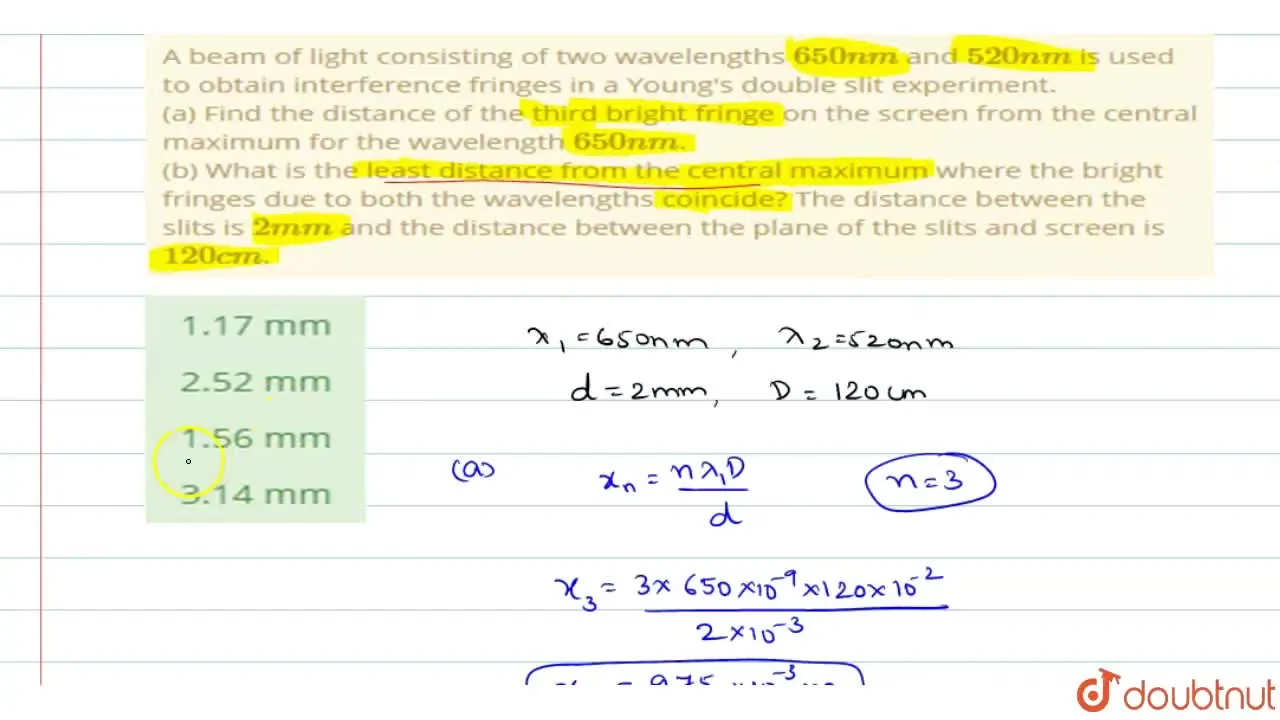A beam of light consisting of two wavelengths 650nm and 520nm is used to obtain interference fringes in a Young's double slit experiment.
(a) Find the distance of the third bright fringe on the screen from the central maximum for the wavelength 650nm.
(b) What is the least distance from the central maximum where the bright fringes due to both the wavelengths coincide? The distance between the slits is 2mm and the distance between the plane of the slits and screen is 120cm.
1.17 mm
2.52 mm
1.56 mm
3.14 mm
The correct Answer is:C
Let at linear distance 'y' from center of screen the bright fringes due to both wavelength coincides. Let n1 number of bright fringe with wavelength λ1 coincides with n2 number of bright fringe with wavelength λ2.
We can write
y=n1β1=n2β2
n1λ1Dd=n2Dλ2d or n1λ1=n2λ2 ...(i)
Also at first position of coincide, the nth bright fringe of one will coincide with (n+1)th bright fringe of other.
If λ2<λ1,
So, then n2>n1 and n2=n1+1 ...(ii)
Using equation (ii) in equation (i)
n1λ1=(n1+1)λ2
n1(650)×10−9=(n1+1)520×10−9
65n1=52n1+52 or 13n1=52 or n1=4
Thus, y=n1β1=4[(6.5×10−7)(1.2)2×10−3]
=1.56×10−3m=1.56mm
So, the fourth bright fringe of wavelength 520 nm coincides with 5th bright fringe of wavelength 650 nm.
Related Playlists
- BOOK - NCERT FINGERTPS ENGLISHCHAPTER - WAVE OPTICSEXERCISE - NCERT EXEMPLAR PROBLEMS5videos
WAVE OPTICS
- BOOK - NCERT FINGERTPS ENGLISHCHAPTER - WAVE OPTICSEXERCISE - ASSERTION & REASON CORNER15videos
WAVE OPTICS
- BOOK - NCERT FINGERTPS ENGLISHCHAPTER - WAVE OPTICSEXERCISE - Assertion And Reason15videos
WAVE OPTICS
- BOOK - NCERT FINGERTPS ENGLISHCHAPTER - SEMICONDUCTOR ELECTRONICS : MATERIALS , DEVICES AND SIMPLE CIRCUITS EXERCISE - Assertion And Reason15videos
SEMICONDUCTOR ELECTRONICS : MATERIALS , DEVICES AND SIMPLE CIRCUITS
Similar Questions
A beam of light consisting of two wavelength, 650 nm and 520 nm, is used to obtain interference fringes in a Young's double - slit experiment. Find the distance of the third bright fringe on the screen from the central maximum for wavelengths 650 nm.
View SolutionA beam of light consisting of two wavelengths 6500A0 and 5200A0 is used to obtain interference fringes in a Young's double slit experiment.
Find the distance of the third bright fringe on the screen from the central maximum for wavelength 6500A0. The distance between the slits is 2mm and the distance between the plane of the slits and the screen is 120 cm.View SolutionA beam of light consisting of two wavelengths, 650 nm and 520 nm is used to obtain interference fringes in Young's double-slit experiment. What is the least distance (in m) from a central maximum where the bright fringes due to both the wavelengths coincide ? The distance between the slits is 3 mm and the distance between the plane of the slits and the screen is 150 cm.
View SolutionA beam of light consisting of two wavelenths, 6500 Å and 5200 Å is used to obtain interference fringes in a Young's double slit experiment (1Å=10−10m). The distance between the slits is 2.0 mm and the distance between the plane of the slits and the screen in 120 cm. (a) Find the distance of the third bright frings on the screen from the central maximum for the wavelength 6500 Å (b) What is the least distance from the central maximum where the bright frings due to both the wavlelengths coincide ?
View SolutionA beam of light consisting of two wavelengths, 650 nm and 520 nm is used to obtain interference fringes in Young's double-slit experiment. What is the least distance (in m) from a central maximum where the bright fringes due to both the wavelengths coincide ? The distance between the slits is 3 mm and the distance between the plane of the slits and the screen is 150 cm.
View SolutionA beam of light consisting of two wavelengths 6500A0 and 5200A0 is used to obtain interference fringes in a Young.s double slit experiment.
What is the least distance from the central maximum where the bright fringes due to both the wavelengths coincide? Distance between the slits is 2mm, distance between the slits and the screen L=120cm.View SolutionA beam of light consisting of two wavelengths 6500Å and 5200Å is used to obtain interference fringes in YDSE. The distance between slits is 2mm and the distance of the screen form slits is 120 cm. What is the least distance from central maximum where the bright due to both wavelengths coincide?
View SolutionA beam of light consisting of two wavelength 6300A∘ and λA∘ is used to obtain interference frings in a Young's double slit experiment. If 4th bright fringe of 6300A∘ coincides with 5th dark fringe of λA∘, the value of λ(inA∘) is
View SolutionA beam of light consisting of two wavelength , 6500A∘ and 5200A∘ is used to obtain interference fringes in a Young's double slit experiment (1Å=10−10m). The distance between the slits 2.0 mm and the distance between the plane of the slits and the screen is 120 cm. Find the distance of the third bright fringe on the screen from the central maximum for the wavelength 6500Å.
View SolutionA beam of light consisting of wavelengths 6000 Å and 4500 Å is used in a YDSE with D = 1 m and d = 1 mm. Find the least distance from the central maxima, where bright fringes due to the two wavelengths coincide.
View Solution


